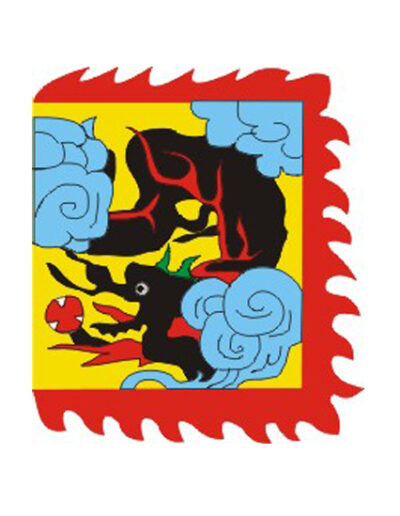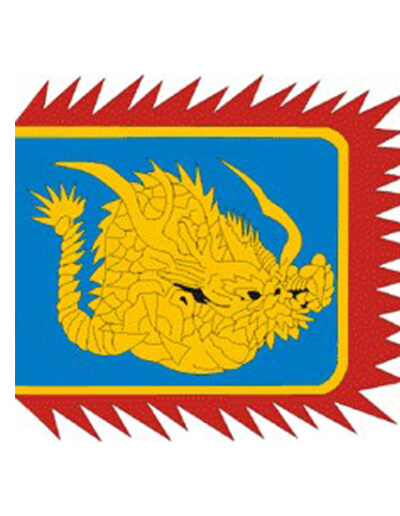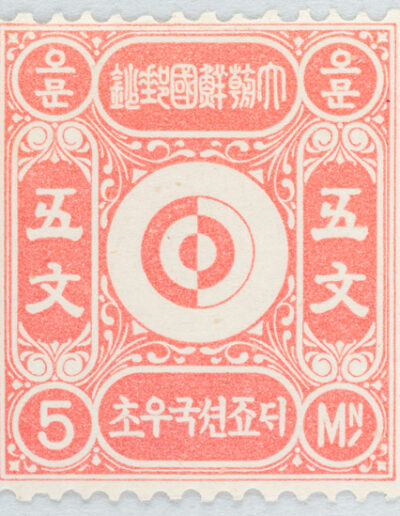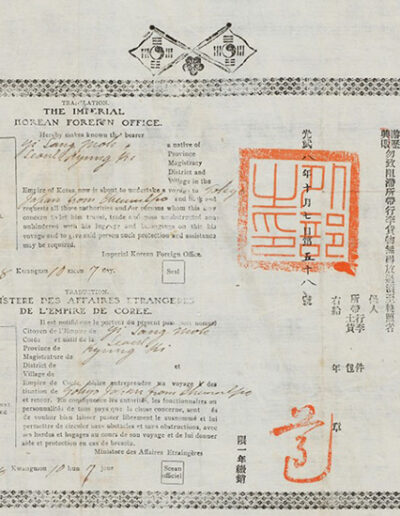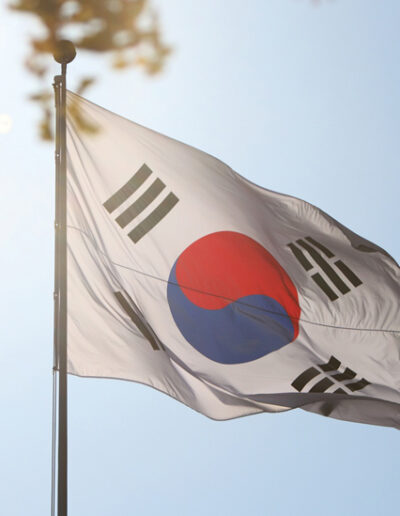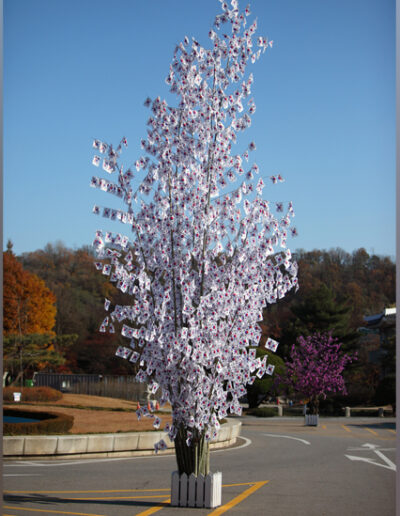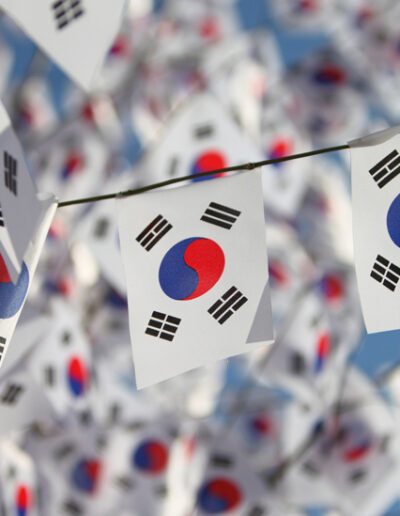The Taegeukgi
1882
About the Object
Story of the Object
Teaching suggestions
Classroom Extras
![85-7657 National Korean Flag "Kukki" [Flag]. Korean. E151638-0.](https://teaching-korea.co.uk/wp-content/uploads/2024/05/85-7657.jpg)
The Jouy Taegeukgi, collected by American visitor Pierre Louis Jouy in Korea, c1884
E151638, © Department of Anthropology, Smithsonian Institution
The Taegeukgi
The first national flag of Korea, the Taegeukgi, was created in 1882.
Before that time, the kings of the Goryeo and Joseon dynasties, (918-1392 and 1392-1897 respectively) had had their own royal flags (known as ‘standards’).
However, these were personal standards and represented the monarchs themselves and their ruling families.
These flags were not seen as representing the whole country.
During the 18th and 19th Centuries, it became increasingly common for countries to have national flags which represented the state when it was involved in international discussions and events.
In 1882 the first flag to represent Korea, the Taegeukgi, was created and displayed on an official visit to Japan by the envoy of Korea.
In the following year King Gojong declared the Taegeukgi to be the official national flag.
The history of the Taegeukgi
Before 1882, the monarchs of the Goryeo and Joseon dynasties had had their own royal standards and processional flags.
During the Goryeo period, the principal flag was the Bong-gi – The Phoenix Flag – and it displayed a phoenix upon a yellow background.
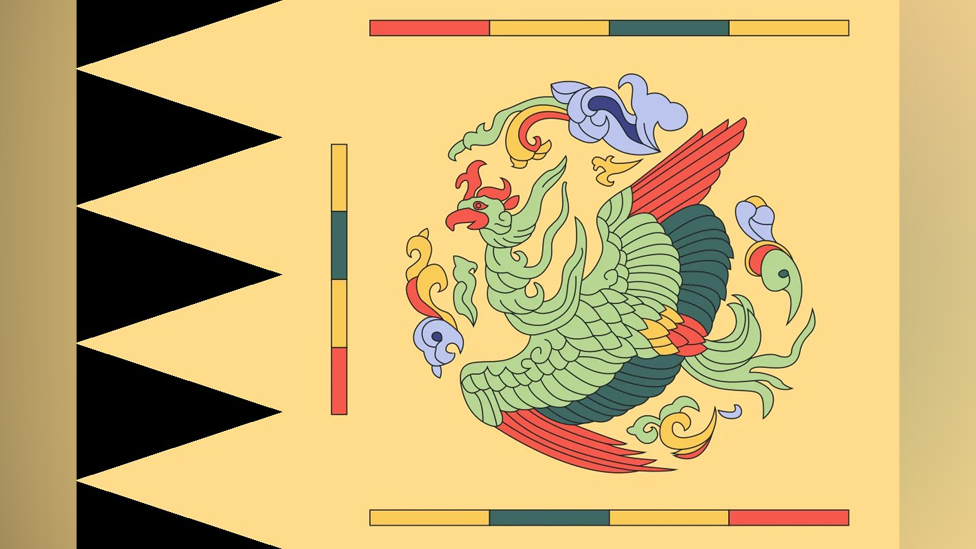
The Phoenix Flag of Goryeo
They also used the Haema-gi (Seahorse Flag)’and the Sang-gi (Elephant Flag).
The Joseon rulers also had a range of flags which tended to be dominated by dragons.
These flags were colourful and clear with a central symbol which dominated the banner.
However, they bore no resemblance to the national flag which was to emerge in the late 19th century.
Although a range of flags were used, during the Joseon period the rulers adopted a royal flag which was similar to that which was approved in 1882.
This is because at the centre was a circular taegeuk symbol surrounded by eight Taoist symbols called trigrams.
These symbols sat upon a red background with a peach border with black triangles.
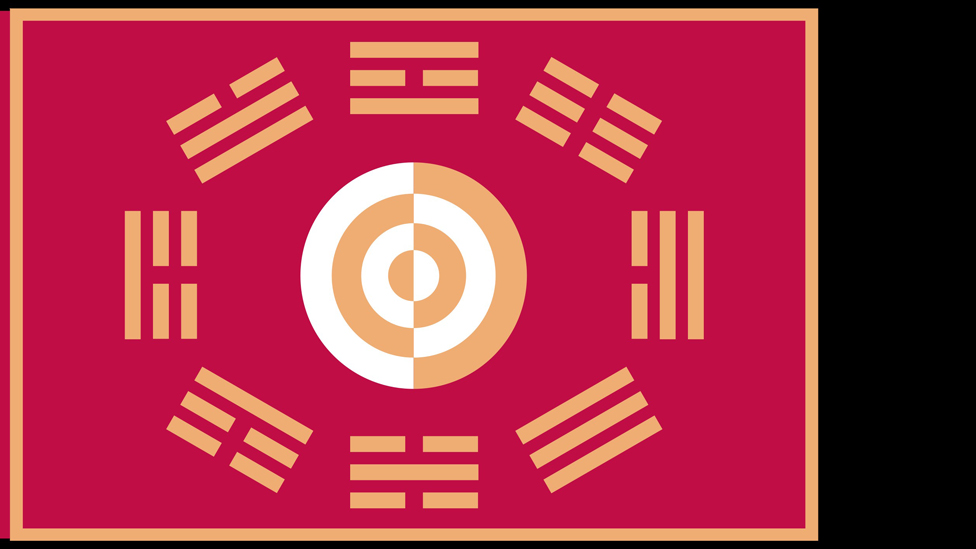
The Royal Standard of the Joseon dynasty 1882-1897
The taegeuk The taegeuk is a Confucian icon which symbolises cosmic balance. It represents the constant interaction between the yin and yang which are the two great opposite but complementary forces at work in the cosmos.
Yin is the female, cold, dark, passive power and represents Earth, rain, soft, evil, black, small, and even (numbers).
Yang represents masculinity, light, and warmth, as well as heaven, sunshine, hard, good, white, large, and odd (numbers).and trigrams A trigram is a figure made up of three whole or broken lines. were widely used in East Asian cultures because it was hoped they would bring success.
In effect, this flag represented the authority of the monarch and symbolized, the king’s harnessing and understanding of the harmonious spirit or energy of the cosmos.
The disadvantage of not having a flag to represent the country was first realised in 1875 during the Ganghwa Incident.
In the second half of the 19th century, the Korean Peninsula was the scene of a power struggle between several imperial powers, including the Russians, the French and the Japanese.
All these countries wanted influence in Korea and favourable trading concessions.
As a result of an unauthorised docking of a Japanese ship at a Korean port and landing of Japanese troops on Korean soil, fighting began which led to the deaths of both Korean and Japanese soldiers.
The Japanese claimed that Joseon troops had illegally attacked a ship bearing the Japanese flag and demanded compensation.
Faced with superior military fighting power, the Joseon government signed the Treaty of Ganghwa Island in 1876 which forced the Korean government to open 3 ports to trade with Japan, specifically Busan, Incheon and Wonsan.
This treaty heavily favoured the Japanese and demonstrated the vulnerability of Korea to the potential influence and pressure from other countries.
During the discussions for this treaty, the Korean representatives realised that they had no flag to fly alongside the one displayed by the Japanese envoy.
At that time, King Gojong (ruled 1864-1907) did not see a flag as being important and necessary and, although there were some proposals to create a national flag, little happened.
However, six years later in April 1882, when discussions were being held for the United States-Korea Treaty of that year (The Treaty of Amity and Commerce), the American envoy suggested that the Koreans should have a national flag to display and to represent the country and its people.
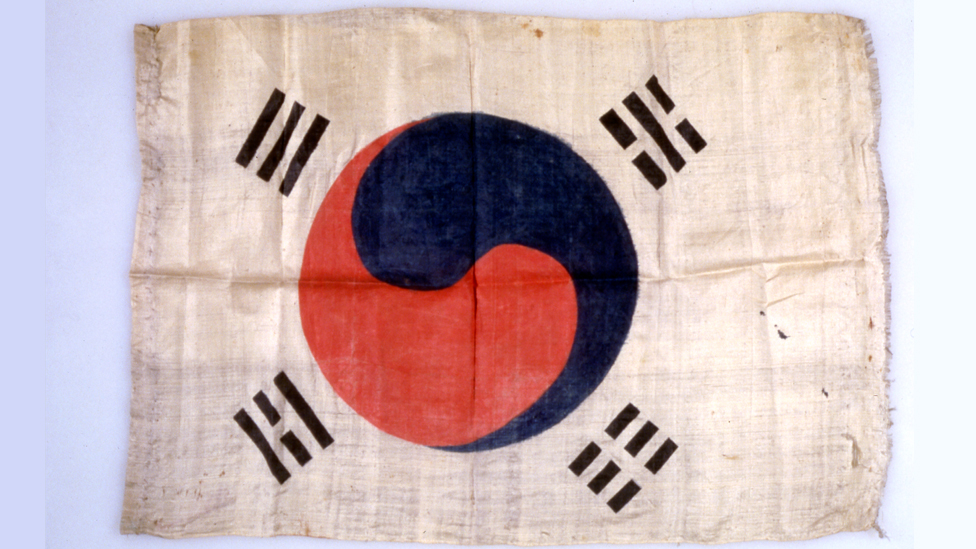
National Korean Flag ‘Kukki’ E151638, © Department of Anthropology, Smithsonian Institution
Flags had by now become important symbols in international relations.
King Gojong had now come to appreciate that a national flag would be beneficial, and he instructed officials to come up with ideas.
In May 1882 the design proposed by Lee Eung-jun was approved and it was first used by the Special Envoy, Park Yeonghyo, when he represented the Korean nation during an official visit to Japan in 1882.
On 27 January 1883 King Gojong declared the Taegeukgi to be the official national flag and that it would comprise “a swirling taegeuk with four trigrams”.
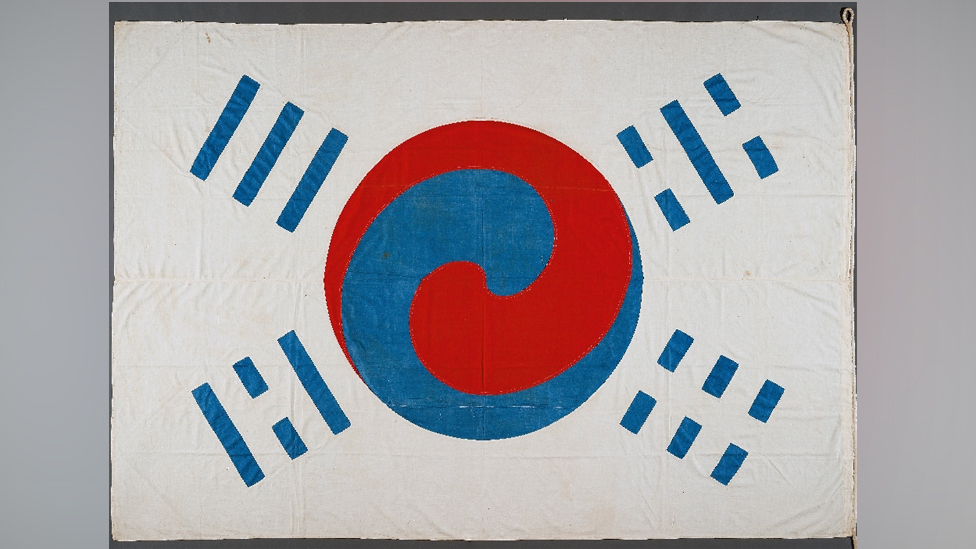
Taegeukgi (Korean National Flag) c1886-1890 © National Museum of Korea
The adoption of the Taegeukgi marked an important shift for the rulers of Korea because they had rejected the symbols of the past such as the phoenix, horses, elephants and dragons.
Instead, they had chosen a Confucian icon and established their authority in announcing their intention to ensure a balance between the yin and the yang.
The development of the Korean flag since 1883
Between 1883 and 1949, the national flag of Korea has undergone several changes but, apart from the period of Japanese colonial rule from 1910-1945, the basic composition of a Taegeuk and four trigrams has remained constant.
In the absence of standardised regulations, some of the flags which have survived from the late 19th century indicate that there were various different arrangements for the positioning of the different trigrams.
The earliest surviving example of an actual flag of Korea is thought to be the ‘Jouy Taegeukgi’, collected by American visitor Pierre Louis Jouy in Korea around 1884.
It has a large taegeuk symbol at the centre and is again surrounded by four smaller black trigrams closely positioned to the Taegeuk.
Nevertheless, between 1897 and 1910 the Korean Empire also used a somewhat more colourful version of the Taegeukgi as the imperial standard.
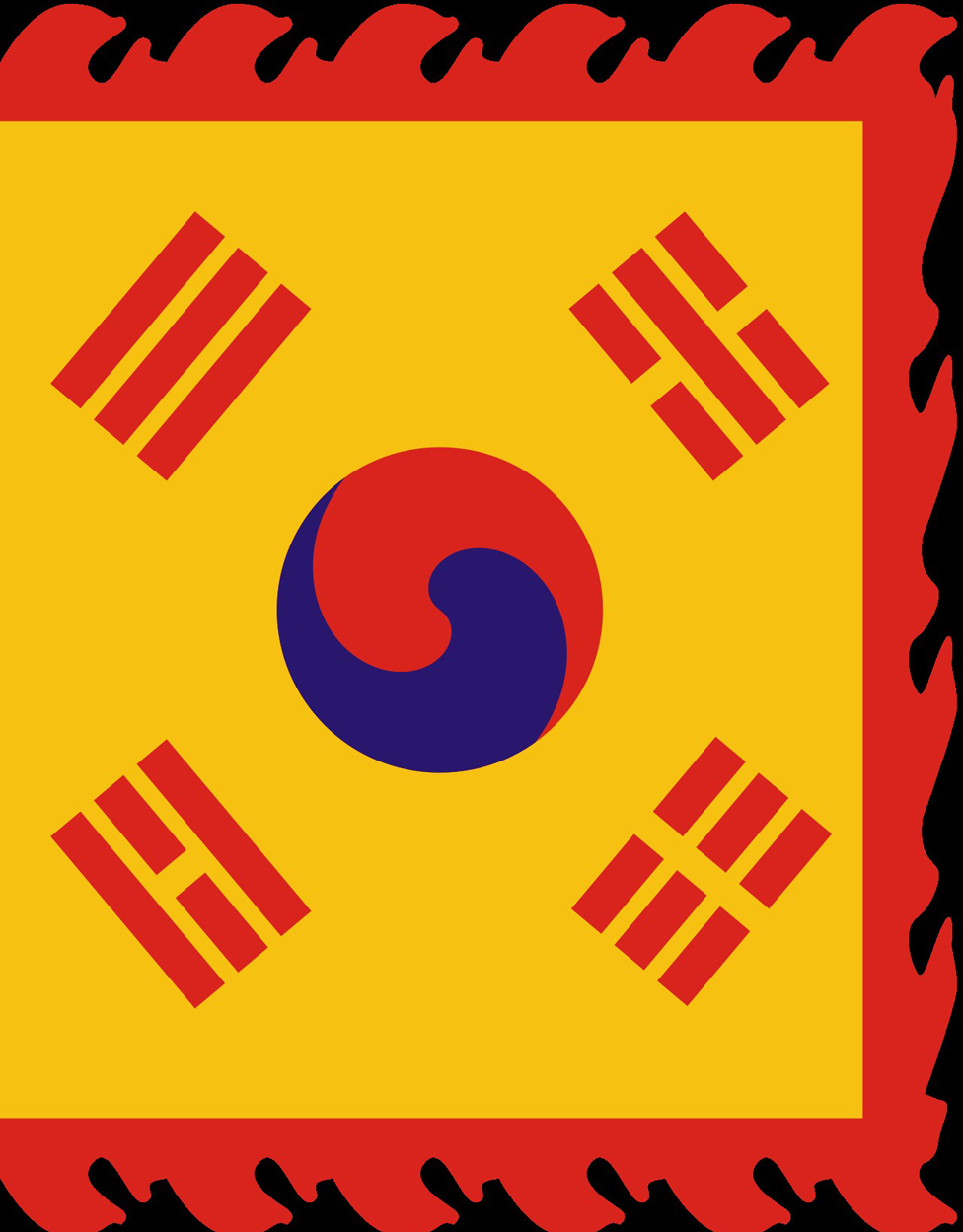
Imperial Standard of the Korean Empire 1897-1910
From the 1880s to the 1910s, though, the Taegeukgi was used by the state on new and modern objects such as postage stamps and passports to represent the authority of the Korean government.
During the Japanese occupation of the Korean Peninsula from 1910-1945, the colonial rulers ignored the Korean flag and adopted a version of the flag of Japan as their flag.
However, although it had been replaced as the official flag, the Taegeukgi became more important to the Korean people.
In particular, it became a symbol of the Korean independence movement which aimed to liberate Korea from Japanese rule.
The movement began in the last years of the 19th century and ended with the surrender of Japan at the end of the Second World War in 1945.
During this period the Taegeukgi was used to represent Korea and acted as a visual representation of a shared national identity at a time when it was under attack by the colonial rulers who tried to eliminate the Korean culture. For example, Korean people were banned from speaking their language and had to adopt Japanese names.
Following the liberation from Japan and the establishment of the government of the Republic of Korea (or South Korea) in 1948, the Taegeukgi came to represent the country, not only the government but also the shared history of the South Korean people.
At the same time the government of the Democratic People’s Republic of Korea (DPRK), or North Korea, created its own very different flag.
In January 1949 the South Korean government formed a National Flag Correction Committee to produce the ‘Official Standards for National Flag Production Methods’ and established the national flag on October 15 of that year.
From that year the composition of the Taegeukgi was standardised and since then various regulations regarding the national flag have been introduced.
They include the methods to be used for manufacturing the flag, as well precise details as to the colours to be used and as to how the flag should be hoisted and flown.
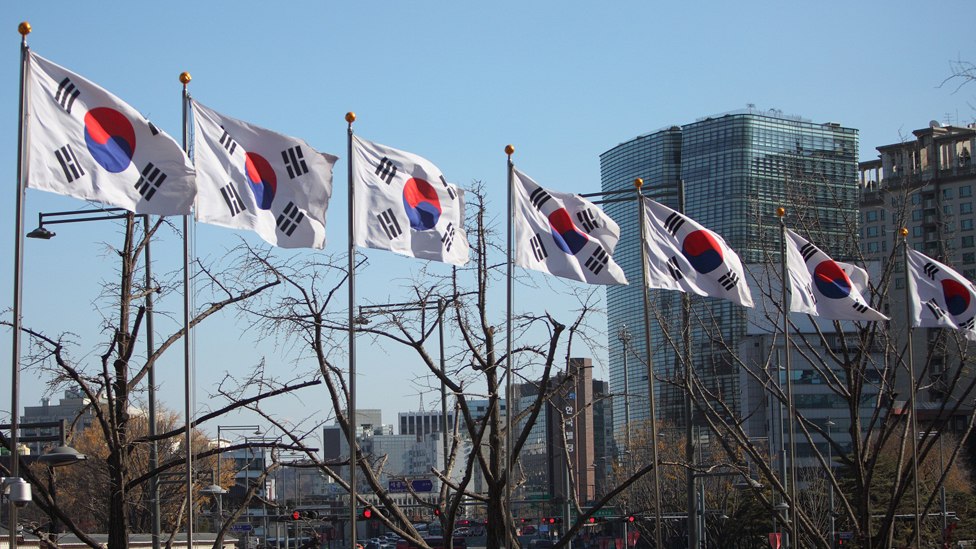
The flag of the Republic of Korea
For the people of South Korea, the national flag is to be honoured and respected; hence the decision to set down in law specific details about its manufacture and its use.
The meaning and symbolism of the Taegeukgi
The Taegeukgi is an immensely symbolic flag and has much meaning both in terms of how it is composed but also in what it represents.
It is made up of a central taegeuk pattern surrounded by four trigrams.
The taegeuk symbol sits at the centre and is divided into two equal sections which symbolise balance in the world and represent the yin and yang.
Whereas the yang at the top is coloured red and represents positive energy, the yin at the bottom is coloured blue and represents negative energy.
Four black trigrams surround the central taegeuk, one in each corner of the flag. They start in the top left-hand corner and move clockwise, and they represent the four fundamental elements, namely air (geon), water (gam), earth (gon) and fire (ri).
As a result, the four trigrams are collectively called geongongamri.
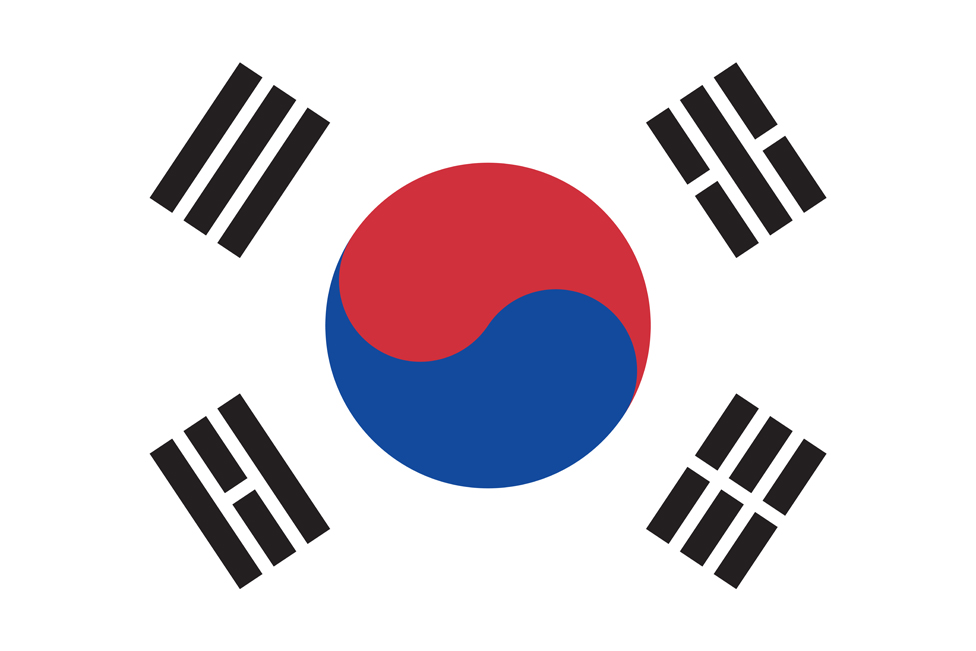 Throughout North East Asia, including Korea, the symbols representing the four elements were regarded as the universe’s basic principles; they show the perpetual cycle of creation, change, and development.
Throughout North East Asia, including Korea, the symbols representing the four elements were regarded as the universe’s basic principles; they show the perpetual cycle of creation, change, and development.
Furthermore, these emblems symbolise vitality, auspiciousness, and fortune, and were believed to repel evil.
The taegeuk and the trigrams are placed on a white background which has been, and still is, a traditional colour in Korean culture. It represents the Korean people’s affiliation with brightness, purity and peace, which are qualities much valued within the country.
The whole design represents a country and people in harmony.
The trigrams also have other meanings as shown in this chart:
| Trigram | Korean name | Celestial body | Season | Cardinal direction | Virtue | Family | Meaning | Social fabric |
| geon | Heaven | summer | south | wisdom | father | justice | The strong stay together | |
| gon | Earth | winter | north | righteousness | mother | vitality | The weak stay together | |
| ri | Sun | spring | east | courtesy | daughter | fruitition | The strong protect the weak | |
| gam | moon | autumn | west | intelligence | son | wisdom | The weak protect the strong |
The importance of the Taegeukgi
The Taegeukgi is highly respected and revered by the people of South Korea.
It is protected by law which sets down clear punishments for desecration of the South Korean national flag. There are fines and prison sentences for anyone, a citizen of South Korea or a foreigner, who damages, removes, stains, or defames a South Korean flag or emblem with intent to insult the South Korean state.
It is also a criminal offence to desecrate the flags of the other nations with intent to insult a foreign country, and prosecution can take place without any complaint from the foreign country so affected.
Although there is this legal protection, the Korean people have immense regard for the national flag.
This is because the flag not only symbolises the state, as national flags do in other countries, but also the Korean race and people.
Even when Koreans are opposed to the actions of the state, they treat their flag with respect and reverence and there is little desecration of the flag as occurs in some other countries across the world.
The traditional Goryeo and Joseon dynastic processional flags had expressed the power of the monarch.
The Taegeukgi, however, has come to express the unity of the people and represent the whole country rather than those who ruled it.
During the late 19th and early 20th centuries it became a symbol around which to rally when the country was under Japanese occupation and the people were focused upon gaining their independence.
In 2009, the Seoul Jingwansa Taegeukgi flag was discovered on the inner wall of the Buddhist altar during the dismantling and restoration of Chilseonggak, an annex building of Jingwansa Temple in Eunpyeong-gu, Seoul.
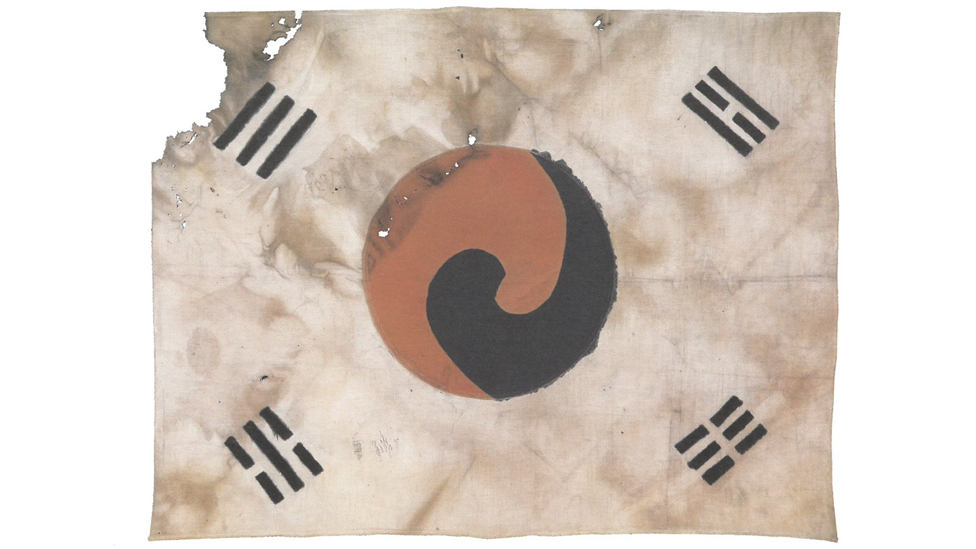
Seoul Jingwansa Temple Taegeukgi, c1919 © Korea Heritage Service
One of the important aspects of this flag, which was made in 1919, was that it was painted over with ink on top of the Japanese flag, it had holes in it, and it was damaged by fire, particularly in the top left-hand corner.
This flag is important because it originates from a time when the Korean people were seeking independence from the colonial invaders, it demonstrates clearly the patriotism of the people and the hatred of the Japanese and the damage appears to suggest it was involved in some violent activity.
As a result, investigating the national flag helps us to understand the Korean people and their history.
It can be seen to demonstrate the unity of the people, represent the struggle for independence, symbolise the authority of the country, establish the country as a separate state, and, since 1948, signify the maturity of South Korea as an economic and political power on the world stage.
According to the government of South Korea, “the Taegeukgi flag embodies the vision of the Korean people who, like the universe, seek continuous creation and enrichment. By upholding the spirit and significance of the Taegeukgi, the people seek to realize unity and unification and contribute to the happiness and peace of humanity”.
The importance of flags
Flags, along with standards and emblems, have been important throughout history.
They were originally used mainly in warfare both at sea and on land.
They identified the location of the kings and leaders as well as specific troops and ships.
They were also used for signalling to others to pass instructions and orders.
Roman legions, for example, had standard bearers which carried the emblems identifying each legion, and acted as a rallying point for the troops in battle.
In ancient China, flags displayed representations of important animals such as a red bird, a white tiger, or a blue dragon. They were carried on chariots and planted upon the walls of captured cities.
The royal flag, however, had all the attributes of kingship, being identified with the ruler himself and treated with a similar respect. It was thus a crime even to touch the flag-bearer. The fall of the flag meant defeat, and the king would rarely expose his flag and his person together, the flag being normally entrusted to a general.
Flags had equal importance in ancient India, being carried on chariots and elephants. The flag was the first object of attack in battle, and its fall would mean confusion and even defeat.
To be useful a flag needed to blow out freely in the wind and to have a message on it which could be clearly seen and identified.
As a result, flags came to be made of a light material and to carry a device or pattern identical on both sides.
Wording tended to be excluded, colours tended to be bright and simpler patterns were favoured.
Over time flags came to represent authority. As a result, they were flown over castles and other buildings associated with the flag owner, more often than not a local noble in an area of a country and a ruler for the whole country.
It was hoped that the flags, standards and emblems would help those associated with them to be successful, and, in the case of royal flags, the people were to treat them with a level of respect similar to that given to the ruler.
National flags have become an indispensable part of our lives, and their history is worthy of study. This is because through their various iterations they can reveal much about a country’s political, social and cultural development, and their visual imagery displays what is important at different times in their history.
In the case of Korea before 1945 and South Korea since liberation, flags have included exotic animals, bright colours, and no words.
They were used for signalling, decoration and display, and, from the late 19th Century, they came to represent the country of Korea, the struggle for independence, the power and authority of the government at home and abroad, and the people themselves.
Retrieval practice
1. In which year was the Taegeukgi, the first national flag of Korea, created?
a) 1852
b) 1882
c) 1912
2. What name is given to a figure made up of three whole or broken lines?
a) A Tripod
b) A Triton
c) A Trigram
3. The Taegeukgi was first used by the Special Envoy, Park Yeonghyo, when he represented the Korean nation during an official visit to which country?
a) Japan
b) China
c) Germany
Famous Flag Facts
Ask students to research the stories of other famous flags. The following have fascinating stories relating to their creation – but students could pick one, three, or five of their own choices to research. This could be an individual or group project:
- The flag of the United States of America: the current version of the flag is the 27th; the design of the flag has been modified officially 26 times since 1777.
- The flag of the United Kingdom: the flag consists of three heraldic crosses – the cross of St George to represent England, the cross saltire of St Andrew to represent Scotland, and the cross saltire of St Patrick, the patron saint of Ireland. The Welsh dragon does not appear on the Union Flag.
- The flag of Brazil: a blue disc depicting a starry sky, a curved band inscribed with the national motto Ordem e Progresso (Order and Progress), all within a yellow rhombus, on a green background. The stars represent the constellations as seen from Rio de Janeiro on 15 November 1889, the day Brazil became a republic.
The importance of flags
Write an extended answer or essay outlining the use and importance of flags throughout history:
- Why were flags originally created?
- When were they first used?
- How have they been used in history? Find examples of how flags have been used – for example, the Normans from France used flags to move soldiers around on the battlefield when they invaded England in 1066, whilst whole armies have used flags (white ones) to show they are surrendering.
- Which country has the oldest flag?
- What fascinating flag stories can be found?
Write a quiz and test your classmates
Ask your students to use the About the Object section, and other sources, to write quiz questions and accompanying answers. Model this as students find it difficult to frame questions well. They also need guidance on how to write quiz questions which end with a definitive answer. Here are three example questions and answers that you could use a model:
1. Question: In which country was the first Korean flag – the Taegeukgi displayed in?
Answer: Japan (on an envoy’s official visit to Japan).
2. Question: What do the two equal sections in the central circle symbolise?
Answer: Balance in the world AND / OR ying and yang.
3. What two types of punishment are used for anyone who desecrates (purposely damages) the Korean flag?
Answer: Fines and a prison sentence.
Research flag signals and send your own messages
Flags have been used to in the past as means of communication. For example, in the 18th and early 19th Centuries, flags were used by the British navy to send messages between war ships.
This was standardised the early 19th Century. Indeed, Admiral Nelson famously sent his fleet a famous message via flags. He expected, “every man to do his duty” and sent this as a flag message.
Ask your students to research how flags have been used to send messages. They could also make their own flag signal. There is a brilliant activity designed to do this on the Royal Museums Greenwich website.
Write a summary for the flag displayed at the National Museum of Korean Contemporary History
Ask your students to research and then write a 40-word summary didactic (the blurb that accompanies a display item) explaining the history of this flag and its significance in the development of modern Korea.
Classroom Extras
Here you will find a number of images, video clips and website links which can be used as extras for teaching in the classroom or for use by pupils undertaking independent research.
Images
The Flag of the Joseon dynasty – a yellow flag with a black Chinese style dragon and blue clouds with red fringe.
The Personal Standard of the King of Joseon – a blue flag with a yellow Chinese style dragon with yellow border and red fringe.
The National Flag on display in a classroom at Unjung Elementary School, Seongnam, Gyeonggi-do, South Korea
The National Flag on display in the school hall at Unjung Elementary School, Seongnam, Gyeonggi-do, South Korea
Videos

Discover more online
Wikipedia: The Flags of South Korea
Wikipedia: A list of the flags of Korea
Wikipedia: The history and meaning of Taegeukgi
E-Government website of the Republic of Korea: The history and meaning of Taegeukgi
Ministry of the Interior and Safety: The National Flag – Taegeukgi
Smart History: the Center for Public Art History : The creation of a Korean national flag, 1880s–1910s, Jihyun Son
Flags of the World: Korea : History of the South Korean flag







